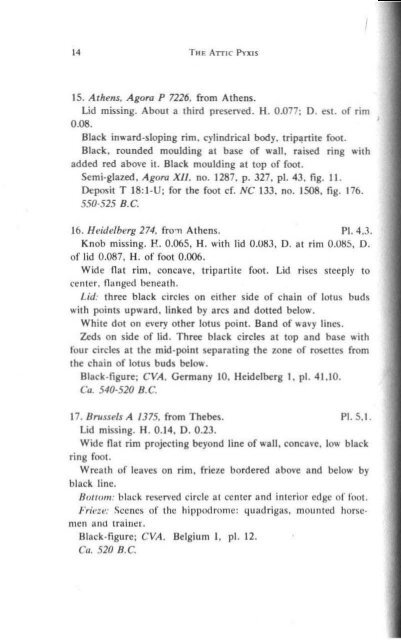Create successful ePaper yourself
Turn your PDF publications into a flip-book with our unique Google optimized e-Paper software.
14<br />
THE ATTIC PvXlS<br />
SAllY ROVHERFURD ROIlERn<br />
15<br />
IS. Athen.s, Agoru P n26. from Athens.<br />
lid missing. About a third preserYed. H. 0.077: D. eSI. of rim<br />
0.08.<br />
Black inward-sloping rim. cylindrical body. trip'!r1ite foot.<br />
Black. rounded moulding at base of wall. raised ring with<br />
added red abm'c it. Black moulding at top of foot.<br />
Semi-glazed. Agoro XII. no. 1287. p. 327. pI. 43. fig. 11.<br />
Deposit T 18:)·U; for the foot cf. Ne 133. no. 1508. fig. 176.<br />
550·515 B.C.<br />
16. Hf'ideJberg 274, froon Athens. PI. 4.3.<br />
Knob missing. H. 0.065. H. with lid O.O~S3, D. 301 rim O.OMS. D.<br />
of lid 0.087. H. of foot 0.006.<br />
Wide nal rim. concave. tripartite foot. Lid rises steeply to<br />
eenter. nanged beneath.<br />
Lid: three black circles on either side of chain of lotus buds<br />
with points upward. linked by arcs and dotted below.<br />
White dot on c\'ery other lotus point. Band of wavy tines.<br />
Zeds on sKle of lid. Three black circles at top and base with<br />
four circles at the mid-point separating the zone of rosettes from<br />
the chain of lotus buds below.<br />
Black.figure; CVA, Gemlany 10. HeKlelberg I. pI. 41.10.<br />
Ca. 540-520 B_C.<br />
17. Brussels A 1375, from Thebes. PI. 5.1.<br />
Lid missing. H. 0.14, D. 0.23.<br />
Wide flat rim projecting beyond line of wall. concave. Iow black<br />
ring foot.<br />
Wreath of leaves on rim. frieze bordered above and below by<br />
black line.<br />
8fJ1wm: black reserved circle at center and interior edge of foot.<br />
Fr;eze: Scenes 01" the hippodrome: quadrigas. mounted horsenlen<br />
and traill~r.<br />
Black.figure; CVA, Belgium I. pI. 12.<br />
Cu. 520 B.C.<br />
A • lIS Agora P /JI29. from AtMns.<br />
18. t e . .<br />
Lid missing. About a third p~rved. H. rres. 0.042. D. est. at<br />
rim ca_ 0.03. .. .<br />
Conca\"e. inset flange for lid. tnpartlte foot.<br />
Red line at top. black line at base of wall, black band around<br />
middle.<br />
Semi-glazed. AgQI"Q Xli. 327. no. 1288. pI. 43. fig. 11. Deposit<br />
U 25,2·L.<br />
550-525 B.C.<br />
I~. Princetorl. private.<br />
One foot restored, H. 0.085. H. with lid 0.14. D. at rim 0.09. D.<br />
of lid 0.095.<br />
Concave. wilh wide flat rim, four feet. Lid flanged beneath.<br />
Three reserved lines on rim. another around middle of wall and a<br />
grooved line near the lower edge. Vertical rilled edge of lid and<br />
'''''0 circles on upper surface reserved. Added red for under<br />
surface of rim at base of wall. vertical edge of lid and moulding at<br />
base of knob.<br />
Black. Agora XII. 320. no. 1286. pI. 43. fig. 11.<br />
Ca_ 515 B.C.<br />
~ earliest example (no. I) comes from a ehild's urn burial in<br />
the Athenian Agora dated ca. 6(X) B.e. The shape carelessly made<br />
and decorated reflects the concave form of the Early Corinthian<br />
prototype.<br />
Athens 316 (no. 2. PI. 1.1) is a replica of the Early Corinthian<br />
form minus the handles. The rim slopes slightly inwards and its<br />
lid may well have been like that of Boston (no. 7. Fig. la). The<br />
range of vase shapes decorated by the Polos Painter is derived<br />
from Corinth.]<br />
. Another slightly later pyxis dated 10 the second quarter of the<br />
SIxth century is derived from a variant of the Early Corinthian<br />
shape in which the vase is formed as a kalathos with flat handles<br />
at the eenter of the body.• The Ceramicus pyxis (no. 3) is shaped<br />
as a kalathos but the handles are at the rim and the lid curves<br />
toward the center as in the normal Early Corinthian type. An

















